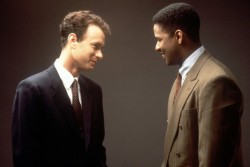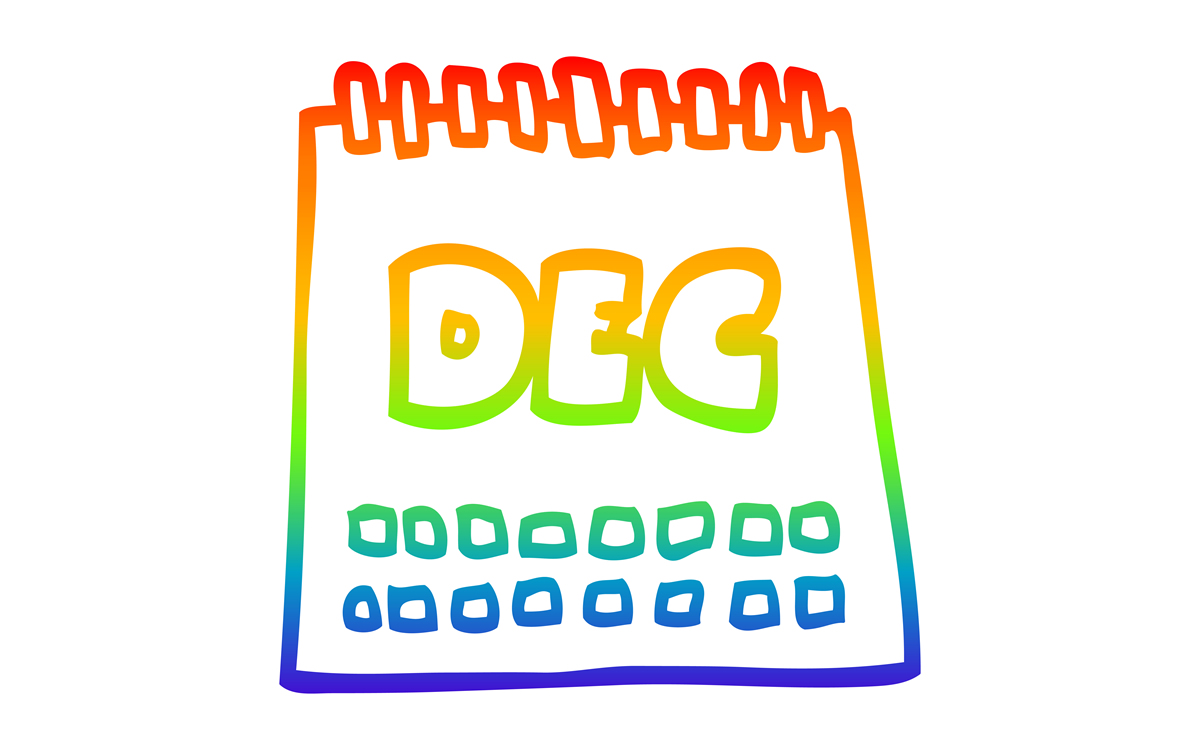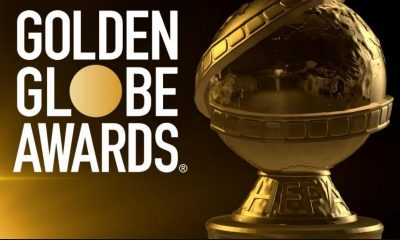Arts & Entertainment
AIDS and the arts
From the Quilt to Hollywood to Broadway, pop culture helped us make sense of grief, loss


The cast of ‘The Normal Heart’ at Arena Stage. The show, a groundbreaking dramatization of the early years of the AIDS crisis in New York, runs through July 29. (Photo by Scott Suchman; courtesy Arena)
The International AIDS Conference in Washington offers an opportunity to look back at how artists have responded to the disease. Since the very first days of the crisis, artists of all kinds have actively responded, both in their artistic works and as fundraisers and activists.
THE NAMES PROJECT AIDS MEMORIAL QUILT
The Names Project AIDS Memorial Quilt, on display throughout the city through the month of July, is the largest community art project in the world. More than 48,000 panels have been created by lovers, family members and friends to memorialize those who have died of AIDS. The Quilt has redefined the traditional folk-art of quilt-making into a modern art form that serves as a memorial, a tool for education, a work of art and a call to arms. Each of the panels has been photographically preserved in the AIDS Memorial Quilt Archive. About 14 million around the world have seen panels from the Quilt.
The Quilt has its root in a powerful piece of political theater. While preparing for the annual candlelight march honoring Harvey Milk and George Moscone in 1985, San Francisco activist Cleve Jones was shocked to learn that more than 1,000 people in the city had already died of AIDS. He asked his friends to bring placards with the names of the dead to the march. After the march, the activists taped the placards to the side of the San Francisco Federal Building and realized that the signs now looked like a patchwork quilt. Inspired by the sight, Jones and his friends made plans for a larger memorial and in 1986 Jones created the first quilt panel in honor of his friend Marvin Feldman.
THE ART OF ACTIVISM
One of the remarkable features of the fight against AIDS has been the ability to use visual art to generate a powerful public response. This was especially true for the AIDS Coalition to Unleash Power (ACT UP), an international direct action advocacy group that worked to impact the lives of people with AIDS. Founded in New York City in 1987, the leaderless anarchist network effectively combined powerful direct action protests with provocative visual images to effectively generate media attention for their cause.
Veteran media activist Cathy Renna, who describes herself as “coming out and coming of age” when ACT UP was forming, says the global impact of the group came from its ability to use visual art to drive home a message.
“They had people like Ann Northrup and Larry Kramer who understood the media really well and who understood the power of images,” Renna says. “They created iconic images that demanded the attention of the media and became embedded in the minds of people.”
Renna notes that the members of ACT UP really showed the power of visual art to move people and the power of creativity and humor to reach people.
“Not everyone agreed with their tactics, but at the end of the day none of us can argue with the indelible impact they had on the public perception of AIDS and the entire LGBT movement,” she says.
CLASSICAL MUSIC
For centuries, there’s been a debate about how well classical music can respond to specific cultural events. Gay composer John Corigliano leapt into this fray when he wrote his Symphony No. 1 in 1991 as a response to the AIDS epidemic.
“During the past decade I have lost many friends and colleagues to the AIDS epidemic, Corigliano writes in his notes to the first recording of the symphony. “My First Symphony was generated by feelings of loss, anger and frustration.”
Corigliano, best known for his opera “The Ghost of Versailles” and his Oscar-winning score for “The Red Violin,” says that the form of his AIDS symphony was inspired by a viewing of the NAMES Project AIDS Memorial Quilt.
“A few years ago I was extremely moved when I first saw ‘The Quilt,’ an ambitious interweaving of several thousand fabric panels, each memorializing a person who had died of AIDS, and most importantly, each designed and constructed by his or her loved ones,” he wrote. “This made me want to memorialize in music those I have lost, and reflect on those I am losing.”
THEATER
Perhaps no other artistic medium has been as responsive to the AIDS crisis as theater. From ground-breaking pieces like Larry Kramer’s “The Normal Heart” (an Arena Stage production runs through July 29) and William Hoffman’s “As Is” to such recent works as “The Book of Mormon.” The theatrical community has been deeply involved in the artistic and activist response to AIDS. Here’s a sampling of plays and musicals that have AIDS as a central theme.
“Angels in America: A Gay Fantasia on National Themes.” Part One of Tony Kushner’s sprawling epic (“Millennium Approaches”) opened on Broadway in May 1993, and Part Two (“Perestroika”) followed in November of that year. The play centers on Prior Walter, a gay man in Manhattan who has just been diagnosed with AIDS as the play opens. Over the course of the seven-hour theatrical extravaganza, Prior is abandoned by his lover Louis, who leaves him for a closeted Republican lawyer; befriends the Mormon’s mother and wife, who takes Valium in “wee little fistfuls,” is nursed by his ex-lover, the fierce snap queen Belize; and, is visited by an angel who wants to recruit him as a prophet. The play won the Pulitzer Prize and several Tony Awards and was adapted into both an award-winning movie by HBO Films and an opera by Hungarian composer Péter Eötvös.
“The Normal Heart” by Larry Kramer was one of the earliest plays to deal with AIDS. Now playing at Arena Stage, the play is a thinly veiled autobiography of the author and the founding of Gay Men’s Health Crisis.
“Before It Hits Home” by Cheryl West was one of the first dramas to focus on the impact of AIDS on the African-American community. Wendal is a bisexual jazz musician who denies his sexual encounters with men even after he is diagnosed with AIDS. He tries to hide the truth from his pregnant girlfriend and his married boyfriend, but as his health deteriorates, he is forced to return to his family and confess the truth.
“Rent” is Jonathan Larson’s hit musical and a loose adaptation of Puccini’s “La Boehme” set on the lower East Side of Manhattan in the early 1980s. Larson’s musical landscape includes a variety of artists in a variety of straight and LGBT sexual situations. Many of the characters have AIDS and the Act II opener, “Seasons of Love” has become a popular anthem for the fight against AIDS.
The musical “Falsettos,” produced in Washington in 2010 by the now-closed Ganymede Arts, brings together two one-act musicals by William Finn written a decade apart. In “March of the Falsettos,” Marvin moves in with his male lover Whizzer, much to the distress of his ex-wife, his psychiatrist and his son. In “Falsettoland,” the extended family, now including “the lesbians from next door,” reunite to support Whizzer and Marvin as they deal with an AIDS diagnosis.
Perhaps most noticeably in theater, it’s possible to also trace how AIDS dramas have evolved over the years.
“’The Normal Heart’ was so significant in its time, but it’s dated now because the disease has changed so much,” says David Jobin, executive director of the Gay Men’s Chorus of Washington, a group that along with its sister choruses has also dealt extensively with AIDS themes. “You see plays now, like ‘Octopus’ by Steve Yockey and it’s dealing with how different generations have responded to the crisis. We now have a whole generation of people whose experience is different and it’s not about loss at all. … all people could concentrate on in ‘The Normal Heart’ was grieving, so it’s become like ‘The Dollhouse,’ a great period piece but not really relevant to today. Which is great in a way that something that’s only 20 years old can already seem so dated. It shows how far we’ve come in treating the disease.”
Jobin says the greatest examples of AIDS-themed art transcend their subject matter.
“You watch something like the HBO adaptation of ‘Angels in America,’ and it becomes so much more than just a statement about AIDS,” he says. “It’s a tour de force for great acting and it’s in a league of its own. I can’t think of a musical or other work that even comes close.”
ARTISTS AS ACTIVISTS
The theatrical community, and the performing arts community in general, have also been incredibly effective at blending art and activism. For example, since 1987 Broadway Cares/Equity Fights AIDS has been raising awareness and funds for AIDS organizations throughout the country. Their popular fundraisers include Broadway Bares, Broadway Barks, Broadway Bears, the annual Easter Bonnet and Gypsy of the Year competitions and the Fire Island Dance Festival.
One of the group’s most effective efforts has been its collaboration with the International Thespian Society, a national network of high school theater troupes. Starting in 1999, high school thespians have organized audience appeals, bucket brigades, silent auctions and special performances to raise money to fight AIDS.
During their annual festival in July 2012, Joe Norton, Broadway Cares’ director of education and outreach, announced that the student artists and activists had raised more than $1 million to support organizations in their communities.
“Thespians know how to effect change by working together and celebrating their love of theater,” Norton says. “And, in the process, they become leaders who raise awareness about HIV/AIDS where they live, while making a difference for so many people in need in their local communities and around the country.”
TELEVISION
Sometimes the artistic response to AIDS has been more about context than content. The popular nighttime ABC soap opera “Dynasty” was groundbreaking in its portrayal of Steven Carrington, the openly gay son of a wealthy Denver oil clan. But its role in the emerging AIDS crisis was due to an off-screen drama.
In 1984, closeted gay Hollywood icon Rock Hudson was cast as Daniel Reece, father of the scheming Sammy Jo Carrington (Heather Locklear). Hudson’s character had a romantic interest in Krystle Carrington, played by series star Linda Evans. Although viewers gossiped about Hudson’s gaunt appearance and producers were worried enough about Hudson’s health to write his character out of the series, no one blinked an eye when Hudson and Evans shared an on-screen kiss.
That changed on July 25, 1985 when Hudson publicly announced that he had AIDS, the first celebrity to reveal his HIV status. He learned that he had AIDS while he was appearing on “Dynasty,” and the soap set suddenly became the focus of a public health controversy. The CDC warned the public about exchanging saliva with members of high-risk groups. Aaron Spelling and the producers of “Dynasty” offered to arrange for AIDS tests for the entire cast. The Screen Actors Guild wrote new rules to regulate on-screen kisses.
Hudson’s revelation, and the subsequent revelation of his homosexuality, suddenly put a public face on the disease and his death on Oct. 2, 1985 set the stage for the first television movie on AIDS. On Nov. 11, 1985, NBC broadcast “An Early Frost” starring Aidan Quinn as Michael Pearson, a successful Chicago lawyer who has not told his colleagues and family about his lover Peter Hilton (D.W. Moffett). When he’s diagnosed with AIDS, he’s forced to go home and tell his family the truth about himself.
MOVIES
A short sampler of independent and mainstream movies that have dealt directly with the AIDS crisis include:
“Parting Glances,” Bill Sherwood’s moving 1986 indie film that was one of the first to deal with AIDS. Richard Ganoung plays Michael who is dealing with concurrent crises: caring for his ex-lover Nick (Steve Buscemi) while his lover Robert (John Bolger) is preparing to leave for a two-year work assignment in Africa.

Tom Hanks (left) and Denzel Washington in ‘Philadelphia,’ a 1993 AIDS-themed Jonathan Demme movie. (Still courtesy TriStar Pictures)
“Philadelphia,” Jonathan Demme’s 1993 drama that was among the first mainstream Hollywood movies to deal with AIDS. Tom Hanks won a Best Actor Oscar for his performance as Andrew Beckett, a closeted lawyer who is fired from his conservative law office when his partners learn he has AIDS. Denzel Washington plays Joe Miller, a homophobic lawyer who helps Beckett sue his former law firm.
“Longtime Companion,” is a 1990 film that takes its title from the homophobic term used by the New York Times and other newspapers to refer to the surviving partners of deceased gay men. It chronicles the early years of the AIDS epidemic from the 1981 article on the mysterious disease occurring among gay men to the beginnings of AIDS activism.
“Tongues Untied” is Marlon Riggs’ stunning 1989 film sought to “shatter the nation’s silence on matters of sexual and racial difference.” It combines documentary footage with fictional stories and episodes from Riggs’ life, as well as footage from civil rights marches and a homophobic stand-up routine by comedian Eddie Murphy.
FICTION
Since the 1980s, countless novelists have tackled the topic of AIDS. From early efforts, such as Armistead Maupin’s “Tales of the City” series to recent books such as Edmund White’s “Jack Holmes and His Friend,” the novel has been a fertile ground for exploring the devastating impact of AIDS on individuals and their society.
One of the most controversial has been “People in Trouble” by lesbian writer and activist Sarah Schulman. The novel deals with a love triangle among artists in the East Village. The controversy, however, arose from Schulman’s accusation that Jonathan Larson lifted the gay plot of “Rent” from her novel. In her 1998 book “Stagestruck: Theater, AIDS and the Marketing of Gay America,” she details the similarities between the two works and critiques how Larson depicts LGBT people and people with AIDS.
Examples
THEATER
Terrence Mc Nally, “Love! Valour! Compassion!”
Cheryl West, “Before It Hits Home”
William Finn, “Falsettos”
William Hoffman, “As Is”
Jonathan Larson, “Rent”
Paula Vogel, “The Baltimore Waltz”
Paul Rudnick, “Jeffrey”
Harvey Fierstein, “Safe Sex”
Larry Kramer, “The Normal Heart” and “The Destiny of Me”
Tony Kushner, “Angels in America”
Robert Lopez, Matt Stone and Trey Parker, “The Book of Mormon”
Broadway Cares/Equity Fights AIDS
POETRY
Mark Doty, “My Alexandria”
Essex Hemphill, “Ceremonies”
Marie Howe, “What the Living Do”
Paul Monette, “Love Alone: 18 Elegies for Rog”
Rafael Campo, “What the Body Told”
Tim Dlugos, “Powerless”
Tory Dent, “What Silence Equals”
TELEVISION
“An Early Frost”
“Dynasty”
“Another World”
“As The World Turns”
“Common Threads: Stories from the Quilt”
“And The Band Played On”
“The Real World”
“Any Mother’s Son”
“In The Gloaming”
FICTION
Christopher Bram, “In Memory of Angel Clare”
Sarah Schulman, “People in Trouble”
Alice Hoffman, “At Risk”
Armistead Maupin, “Tales of the City”
Paul Monette, “Afterlife”
Edmund White, “Jack Holmes and his Friend”
Dale Peck, “Martin and John”
E. Lynn Harris, “Invisible Life”
Felice Picano, “Like People in History”
Sapphire, “Push”
David B. Feinberg, “Spontaneous Combustion”
Samuel R. Delaney, “The Tale of Plagues and Carnivals”
Geoff Ryman, “Was”
CLASSICAL MUSIC
John Corigliano, “Symphony No. 1”
“Classical Action”
MUSIC
“NakedMen”
“Exile”
“Metamorphosis”
“In This Life” by Madonna (from “Erotica”)
ARTS ACTIVISM
ACT UP
Broadway Cares
Names Project AIDS Memorial Quilt
ESSAY
Susan Sontag, “AIDS and Its Metaphors”
Larry Kramer, “The Tragedy of Today’s Gays”
MEMOIRS
Paul Monette, “Borrowed Time”
Reinaldo Areñas, “Before Night Falls”
Mark Doty, “Heaven’s Coast”
Derek Jarman, “At Your Own Risk”
Jamaica Kincaid, “My Brother”Paula W, Peterson, “Women in the Grove”
John Preston, “Winter’s Light”
David Wojnarowicz, “In the Shadow of the American Dream”
PERFORMANCE ART
Ron Athey
Ron Vawter
David Drake
MOVIES
“Longtime Companions”
“Parting Glances”
“Paris is Burning”
“Philadelphia”
“Patient Zero”
“The Living End”
“The Hours”
“It’s My Party”
“Tongues Untied”
VISUAL ARTS
Visual AIDS
Keith Haring
ACT UP and Gran Fury
DANCE
Bill T. Jones, Absence
Neil Greenbery, Not-About AIDS-Dance
UCLA Dance Marathon
Dancers Responding to AIDS
Bars & Parties
Mixtape Sapphics hosts holiday party on Dec. 13
‘Sugar & Spice’ night planned for Saturday

Mixtape Sapphics will host “Sapphic Sugar & Spice: A Naughty-Nice Mixtape Holiday Party” on Saturday, Dec. 13 at 4 p.m. at Amsterdam Lounge.
This is a festive, grown holiday party for queer women and sapphics 35 and older at Revolt’s Christmas pop-up. There will be music, joy, and an optional White Elephant.
This is Mixtape Sapphics’ first-ever holiday party — a cozy, flirty, intentionally grounded night created just for queer women and sapphics 35+ who want real connection, festive joy, and a warm place to land at the end of the year.
Tickets start at $13.26 and can be purchased on Eventbrite.

Friday, December 12
“Center Aging Friday Tea Time” will be at 12 p.m. in person at the DC Center for the LGBT Community’s new location at 1827 Wiltberger St., N.W. To RSVP, visit the DC Center’s website or email [email protected].
Go Gay DC will host “LGBTQ+ Community Happy Hour” at 7 p.m. at Freddie’s Beach Bar and Restaurant. This event is ideal for making new friends, professional networking, idea-sharing, and community building. This event is free and more details are available on Eventbrite.
Women in Their Twenties and Thirties will be at 8 p.m. on Zoom. This is a social discussion group for queer women in the Washington, D.C. area. For more details, go to Facebook.
Saturday, December 13
Go Gay DC will host “LGBTQ+ Community Brunch” at 12 p.m. at Freddie’s Beach Bar & Restaurant. This fun weekly event brings the DMV area LGBTQ+ community, including allies, together for delicious food and conversation. Attendance is free and more details are available on Eventbrite.
The DC Center for the LGBT Community will host “Sunday Supper on Saturday” at 2 p.m. D.C.’s queer community will gather for good food, laughter, and community. For more information, email [email protected].
Sunday, December 14
SADBrunch will host “HokiSlay Drag Brunch” at 12 p.m. at Throw Social. This festive affair brings fierce performances, over-the-top holiday looks, and more sparkle than a tinsel explosion. Expect powerhouse lip-syncs, laughter, and cheer hotter than your spiked cocoa. Cake Pop will host the event. Tickets cost $28.52 and are available on Eventbrite.
Monday, December 15
“Center Aging: Monday Coffee Klatch” will be at 10 a.m. on Zoom. This is a social hour for older LGBTQ+ adults. Guests are encouraged to bring a beverage of choice. For more information, contact Adam ([email protected]).
Genderqueer DC will be at 7 p.m. on Zoom. This is a support group for people who identify outside of the gender binary, whether you’re bigender, agender, genderfluid, or just know that you’re not 100% cis. For more details, visit genderqueerdc.org or Facebook.
Tuesday, December 16
Center Bi+ Roundtable will be at 7 p.m. on Zoom. This is an opportunity for people to gather and discuss issues related to bisexuality or as Bi individuals in a private setting. Visit Facebook or Meetup for more information.
The DC Center for the LGBT Community will host “Self-Defense Class with Avi Rome” at 12:30 p.m. Rome is a proud member of the LGBTQ community and a full-time martial arts instructor with 25 years of teaching experience. He holds a Fifth Degree Black Belt in Jhoon Rhee Tae Kwon Do and is the director of the studio’s Adaptive Tae Kwon Do program for students with special needs. He has also run numerous self-defense workshops for various groups and situations. For more details, visit the center’s website.
Wednesday, December 17
Job Club will be at 6 p.m. on Zoom upon request. This is a weekly job support program to help job entrants and seekers, including the long-term unemployed, improve self-confidence, motivation, resilience and productivity for effective job searches and networking — allowing participants to move away from being merely “applicants” toward being “candidates.” For more information, email [email protected] or visit thedccenter.org/careers.
Asexual and Aromantic Group will be at 7 p.m. on Zoom. This is a space where people who are questioning this aspect of their identity or those who identify as asexual and/or aromantic can come together, share stories and experiences, and discuss various topics. For more details, email [email protected].
Thursday, December 18
The DC Center’s Fresh Produce Program will be held all day at the DC Center for the LGBT Community. People will be informed on Wednesday at 5 p.m. if they are picked to receive a produce box. No proof of residency or income is required. For more information, email [email protected] or call 202-682-2245.
Virtual Yoga Class will be at 7 p.m. on Zoom. This free weekly class is a combination of yoga, breath work and meditation that allows LGBTQ+ community members to continue their healing journey with somatic and mindfulness practices. For more details, visit the DC Center’s website.
Egypt
Iran, Egypt object to playing in Seattle World Cup ‘Pride Match’
Game to take place on June 26

Iran and Egypt have objected to playing in a “Pride Match” that will take place in Seattle during the 2026 World Cup.
The Egyptian Football Association on Tuesday said it told FIFA Secretary General Mattias Grafström in a letter that “it categorically rejects holding any activities related to supporting (homosexuality) during the match between the Egyptian national team and Iran, scheduled to be held in Seattle, USA, on June 26, 2026, in the third round of the group stage of the 2026 World Cup.” Football Federation Islamic Republic of Iran President Mehdi Taj told ISNA, a semi-official Iranian news agency that both his country and Egypt “protested this issue.”
The 2026 World Cup will take place in the U.S., Canada, and Mexico. The draw took place at the Kennedy Center on Dec. 5.
Iran is among the handful of countries in which consensual same-sex sexual relations remain punishable by death.
The State Department’s 2023 human rights report notes that while Egyptian law “did not explicitly criminalize consensual same-sex sexual activity, authorities regularly arrested and prosecuted LGBTQI+ persons on charges including ‘debauchery,’ prostitution, and ‘violating family values.’” Egyptian authorities “also reportedly prosecuted LGBTQI+ individuals for ‘misuse of social media.’”
“This resulted in de facto criminalization of same-sex conduct and identity,” notes the report.
The 2024 human rights report the State Department released earlier this year did not include LGBTQ-specific references.
Soccer has ‘unique power to unite people across borders, cultures, and beliefs’
The June 26 match between Iran and Egypt coincides with Seattle Pride. The Washington Post reported the Seattle FIFA World Cup 2026 Local Organizing Committee decided to hold the “Pride Match” before last week’s draw.
“As the Local Organizing Committee, SeattleFWC26’s role is to prepare our city to host the matches and manage the city experience outside of Seattle Stadium,” said SeattleFWC26 Vice President of Communications Hana Tadesse in a statement the committee sent to the Washington Blade on Wednesday. “SeattleFWC26 is moving forward as planned with our community programming outside the stadium during Pride weekend and throughout the tournament, partnering with LGBTQ+ leaders, artists, and business owners to elevate existing Pride celebrations across Washington.”
“Football has a unique power to unite people across borders, cultures, and beliefs,” added Tadeese. “The Pacific Northwest is home to one of the nation’s largest Iranian-American communities, a thriving Egyptian diaspora, and rich communities representing all nations we’re hosting in Seattle. We’re committed to ensuring all residents and visitors experience the warmth, respect, and dignity that defines our region.”
The 2034 World Cup will take place in Saudi Arabia.
Consensual same-sex sexual relations remain punishable by death in the country. The 2022 World Cup took place in neighboring Qatar, despite concerns over the country’s anti-LGBTQ rights record.
-

 Congress1 day ago
Congress1 day agoEXCLUSIVE: George Santos speaks out on prison, Trump pardon, and more
-

 Health4 days ago
Health4 days agoThe harsh truth about HIV phobia in gay dating
-

 Arts & Entertainment5 days ago
Arts & Entertainment5 days agoCynthia Erivo, Eva Victor, and ‘Blue Moon’ bring queer representation to Golden Globe film nominations
-

 Spain3 days ago
Spain3 days agoVictory Institute honors transgender Spanish senator in D.C.



















